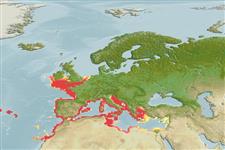Common names from other countries
Environment: milieu / climate zone / depth range / distribution range
Ekologi
; kisaran kedalaman 10 - 180 m (Ref. 113223). Subtropical, preferred 9°C (Ref. 107945); 53°N - 27°N, 32°W - 36°E (Ref. 114316)
Eastern Atlantic and the Mediterranean.
Length at first maturity / Size / Weight / umur
Maturity: Lm ? range ? - ? cm Max length : 11.0 cm SHL jantan/; (Ref. 109255); Umur maksimum dilaporkan: 40 Tahun (Ref. 8702)
An active suspension feeder (Ref. 96376). Infaunal, found on sandy substrates (Ref. 113223).
Life cycle and mating behavior
Kematangan | Reproduksi, perkembang biakan | Pemijahan | telur-telur | Fecundity | Larva
Members of the class Bivalvia are mostly gonochoric, some are protandric hermaphrodites. Life cycle: Embryos develop into free-swimming trocophore larvae, succeeded by the bivalve veliger, resembling a miniature clam.
rujukan utama
Acuan | Koordinator | mitra
Gaspar, M.B., M.N. Santos, P. Vasconcelos and C.C. Monteiro. 2002. (Ref. 2736)
Status IUCN Red List (Ref. 130435)
status CITES (Ref. 108899)
Not Evaluated
Not Evaluated
penggunaan manusia
Perikanan: komersial
FAO - Perikanan: landings | FishSource | Sea Around Us
Alat, peralatan
Sumber internet
Estimates based on models
Preferred temperature
(Ref.
115969): 10.8 - 21.5, mean 18.7 (based on 822 cells).
Daya lenting
sedang, Waktu penggandaan populasi minimum 1.4 - 4.4 tahun (K=0.21-0.38; tmax=40).
keancaman
Low vulnerability (10 of 100).
